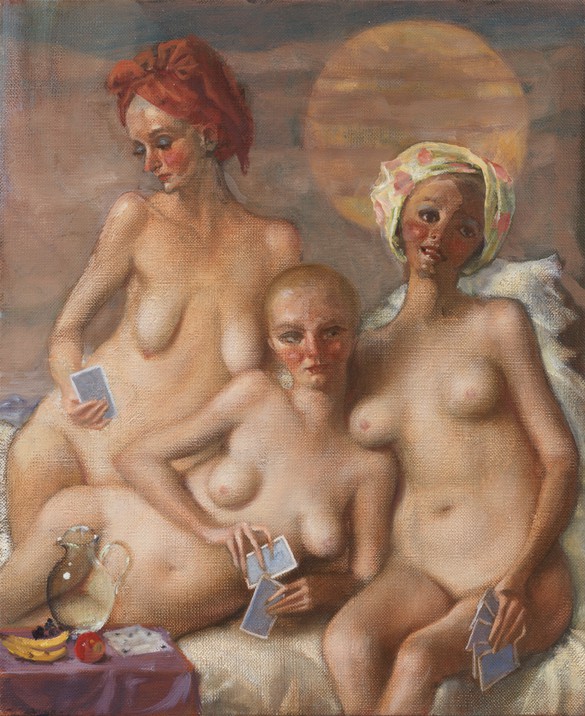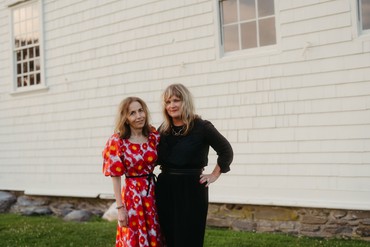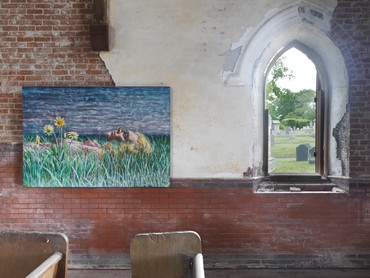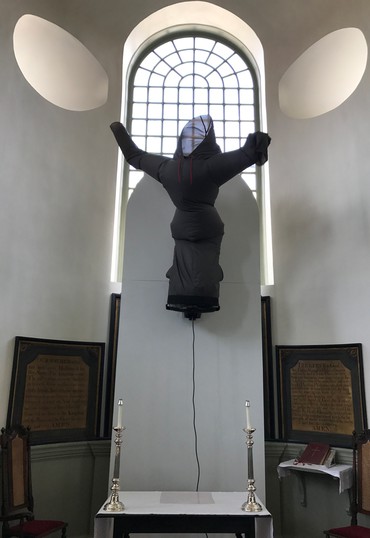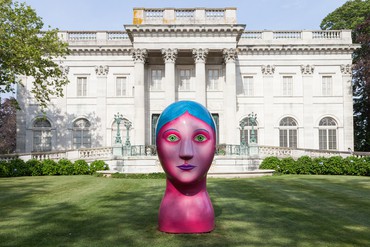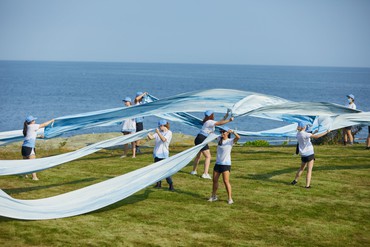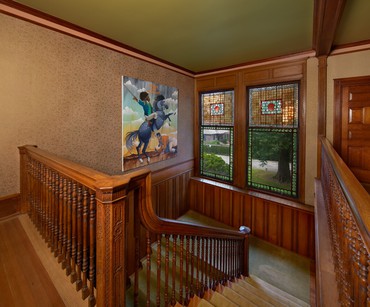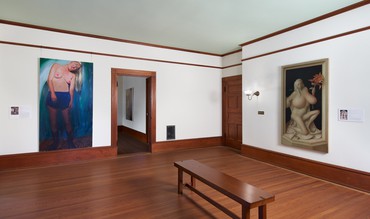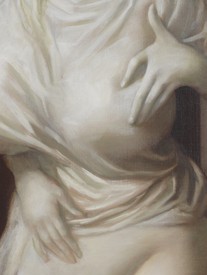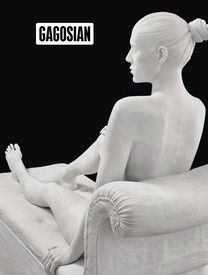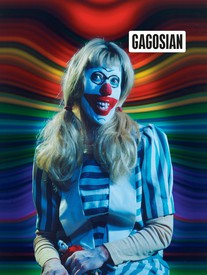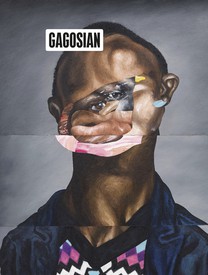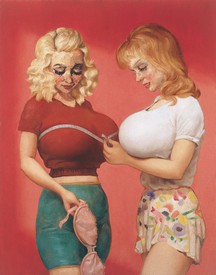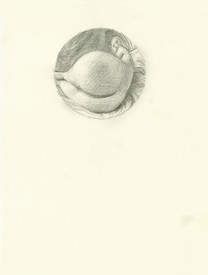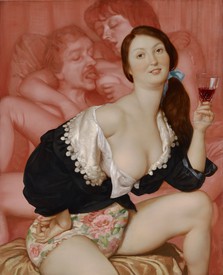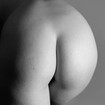
Alison M. Gingeras is a curator and writer based in New York and Warsaw. Her curatorial history spans from the Solomon R. Guggenheim Museum, New York; Centre Pompidou, Paris; and Palazzo Grassi, Venice, to the storefront curatorial space Oko in Manhattan’s East Village. She is currently an adjunct curator at Dallas Contemporary. Independent publisher Heinzfeller Nileisist published Totally My Ass and Other Essays, a collection of Gingeras’s writings, in 2019. Photo: Piotr Uklański, Untitled (Gingerass), 2003 (detail)

Dodie Kazanjian has written about artists and the art world for Vogue since 1989. She is the founding director of Gallery Met, the nonprofit contemporary art space at the Metropolitan Opera, New York, and also of Art&Newport. Her books include Icons: The Absolutes of Style, Dodie Goes Shopping, Vogue: The Covers, and Alex: The Life of Alexander Liberman, which was coauthored with her husband, Calvin Tomkins. From 1981 to 1983, she was Deputy Press Secretary to First Lady Nancy Reagan. She left to join the National Endowment for the Arts, where she started a quarterly magazine called ArtsReview. Photo: Jill Krementz
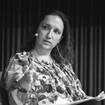
Alison McDonald is the Chief Creative Officer at Gagosian and has overseen marketing and publications at the gallery since 2002. During her tenure she has worked closely with Larry Gagosian to shape every aspect of the gallery’s extensive publishing program and has personally overseen more than five hundred books dedicated to the gallery’s artists. In 2020, McDonald was included in the Observer’s Arts Power 50.
Alison McDonaldNewport as a place has a complex and multilayered history. Around the mid-nineteenth century it became a summer destination for some of the nation’s wealthiest families. It is unique, with historic Gilded Age mansions on the coast and also colonial-era architecture. Dodie, would you share your perspective on Newport—do you have a personal connection?
Dodie KazanjianI was born and raised in Newport. My grandfather came in 1880, more the era of Henry James than Cornelius Vanderbilt. It was the beginning of the Gilded Age, and his import/export business helped furnish the mansions—or “cottages,” as they are commonly referred to in Newport—that were just about to spring up.
AMCDDo you still live there part of the time?
DKI’m here right now. Tad [husband and New Yorker writer Calvin Tomkins] and I spend as much time up here as we can.
AMCDNewport is well known for the jazz and folk music festivals it has hosted for more than fifty years. Do you go to the music festivals?
DKThe Newport Jazz Festival actually started me thinking about Art&Newport in the first place. Newport is a place where there are many benefits and galas; there’s a lot to save here and several organizations dedicated to it: the Preservation Society, the Newport Restoration Foundation, the Island Cemetery, the Newport Historical Society, the wonderful Redwood Library & Athenaeum, the Newport Art Museum. They all need and deserve support. And over the years, I’d often be asked to make donations. I began to realize that I wanted to contribute in a significant way, but what I was rich in was knowing and working with artists.
In all these projects, we’re starting with dusty art historical genres and then bringing in artists who revisit those genres with contemporary concerns.
Alison Gingeras
The Newport Jazz Festival was first organized in 1954 by George Wein and has been a huge success. The town didn’t like it at first, but it was the beginning of Newport becoming global for another reason: culture. That was an eye-opener, to watch through the years as it’s grown—it started with the Newport Jazz Festival and then the folk festival followed. It occurred to me, if jazz could become important for Newport, why couldn’t contemporary art be important here as well?
There’s a long history of artists in Newport that goes back to the portrait painters, such as Gilbert Stuart and Charles Willson Peale, who were here at the end of the eighteenth and early nineteenth centuries. Later on in the nineteenth century, the landscape artists who called themselves Luminists arrived. After that, Newport didn’t draw much attention from contemporary art, with one major exception: Monumenta, the international exhibition of outdoor sculpture in 1974 with big names from Richard Serra and Christo to Claes Oldenberg. But there’s been an enduring focus on the full-length portrait, which was the subject that Alison and I took up last summer in one of the historic and architecturally significant houses of the Preservation Society, the Isaac Bell House.
AMCDAlison, I’d like to ask about your perspective on Newport and how you came to this project.
Alison GingerasWell, my knowledge of Newport is really thanks to Dodie. I visited as a college student but was completely unattuned to its layers and layers of history. And then I spent time in Newport in 2020, when Dodie invited Piotr [Uklański] to make an exhibition in the oldest cemetery in Rhode Island, which is also one of the oldest cemeteries in the United States. I was so impressed by Dodie’s approach to breathing life into the historically loaded sites that are just everywhere in Newport, and bringing artists there to do their own research and respond to the place—whether it’s the architecture or a given history—was really fascinating. So two years later, when Dodie invited me to be part of the exhibition Pictus Porrectus, I fell in love with the town.
Simultaneously, I’d been trying to fill in my own major literary lacunae and I started to read Edith Wharton pretty systematically. Newport always looms in her novels. Even her artist characters are based on real artists, like John Singer Sargent or Giovanni Boldini, who worked there among the wealthy classes. It just feels like an alchemical mixture of site and history, and every artist who we’ve ever brought there gets it immediately; they all have such different responses to it. Bringing not only contemporary art but also contemporary sociopolitical concerns to a place that is so storied and identified with the upper classes has been really exciting as well. In all these projects, we’re starting with dusty art historical genres and then bringing in artists who revisit those genres with contemporary concerns. That’s been a great part of this whole enterprise.
AMCDWhat was the inaugural project for Art&Newport? How do you begin a project like this? Did the community get excited about it early on? Was it a struggle?
DKIt was something I had been thinking about as early as 1995, and it was originally going to be called the Newport Art Festival, you know, in relation to the Newport Jazz Festival. But the years went on and I didn’t do anything with the idea, and in 1999 [the late art critic] Peter Schjeldahl wrote a New Yorker piece on festival art and festivalism that critiqued the commodification of installations at art fairs, which made me realize that we couldn’t call it the Newport Art Festival. So I asked him what to call it, and he came up with the title, but it wasn’t until 2017, when the Newport Art Museum was giving a dinner for Tad and me, that it actually happened. We launched Art&Newport at the event. Ragnar Kjartansson came and performed that night and Paul Chan did an extraordinary intervention at Trinity Church that was up for a couple of weeks. He placed a moving black-hooded figure on the altar, which rattled more than a few people. And then Tony Oursler filled a tent with video projections and smoke. George Condo did a project: the Newport Sexx Festival at the art museum, spelled S-E-X-X as a takeoff on one of George Wein’s early J-A-Z-Z posters. We premiered Condo’s album art for Kanye West’s My Beautiful Dark Twisted Fantasy [2010], which had been banned. We also had Shara Hughes at the Redwood Library.
So we opened with a bang. There were projects in different sites, which shined light on these extraordinary institutions and buildings that are all over town.
There was a lot of controversy at the beginning, especially around Chan’s piece when the minister gave a sermon with the hooded black figure moving behind her—some parishioners found this sacrilegious.
But a little controversy never hurt anybody [laughter].
AMCDWhat presentations followed? What was the second season?
DKThe second season was Shara Hughes; her project, three paintings of the Purgatory Chasm near Newport, came right out of her previous paintings. At the same time, we had Elizabeth Colomba’s Four Seasons (2012–18) at the Elms, in the parlor upstairs. Her four seasons are allegories featuring four different women in her life: her mother as winter, her niece as spring, and so on. She paints the Black body into very white, Anglo-Saxon, nineteenth-century settings. We placed her paintings in a room alongside other quite traditional full-length portraits of Newport’s high society women. Her paintings are six feet tall and thirty inches wide; they are very powerful images.
The next year was Nicolas Party at the Marble House. He installed a ten-foot-tall sculpture of a very colorful and enormous head out front that caused a lot of commotion as people drove up and down Bellevue Avenue. That was a very good experience of collaborating with the Preservation Society. For the next show we invited Piotr to create an exhibition in the cemetery, which we already mentioned.
In 2021, we did In the Waves with Melissa McGill, a performance art piece with dance, painting, and sculptural bodies moving in the landscape at Doris Duke’s house Rough Point. That was with the Newport Restoration Foundation. And the year after that was Alison’s and my joint show, Pictus Porrectus, which led to the current “card players” exhibition.
AMCDWow, that is a very impressive list. And you named several partnerships with community organizations and historical societies. It’s a testament to the program and to you, Dodie, that there are so many successful collaborations. It must be complicated to collaborate with so many different artists, institutions, and locations; there must be a lot of new challenges each time and many different people involved.
DKIt is a lot, but we have a very nimble and knowledgeable board of two art savvy people: Edith McBean and Roger Kass. And it’s wonderful to work at different institutions because we are basically a museum without walls. There’s an ease because we don’t have the overhead of owning real estate. And the mission is to bring attention to these institutions that are already doing such important work.
we are basically a museum without walls. . . . the mission is to bring attention to these institutions that are already doing such Important work .
Dodie Kazanjian
AMCDBefore we delve into the current exhibition, I’d love to learn a little more about Pictus Porrectus, the first show you worked on together in 2022. Alison, what motivated you to cocurate that presentation, and how did you approach the show?
AGDodie and I had been observing how full-length portraiture was starting to bubble up in contemporary practices. Very early on, we thought about Amy Sherald and Kehinde Wiley being commissioned, respectively, for Michelle and Barack Obama’s portraits. We were very excited by the idea of bringing not only ethnic and racial diversity but also class diversity to this codified genre—especially in the Newport context, which was locked into a certain sort of power structure. It was almost like working on a revisionist art history in real time, because we started to make lists of different artists who we knew had done full-length portraits and then artists that we figured would rise to the challenge to make new portraits. The site of the exhibition, the Isaac Bell House, is one of the first modernist structures designed by Stanford White in Newport. It’s an architecturally significant house with many elements of cultural pastiche. So that inspired us to cast the net as wide as possible in terms of artists. One example is Andrew LaMar Hopkins, who’s from New Orleans and considers himself a Creole painter. He created his first-ever life-size portrait for the show by going into his own family history, the history of early American art, and the history of some of the first Black professional painters like Julien Hudson in the nineteenth century. The show also had some queer perspectives on portraiture from artists such as Jenna Gribbon and Salman Toor. We wanted to turn a mirror on contemporary society and show how this dusty genre still had legs.
Umar Rashid made an incredible equestrian portrait that played on Newport the place, but also on the racialized coding of Newport cigarettes, which were specifically marketed to Black Americans. It’s such a clever historical portrait that, again, hanging in this grand Stanford White staircase, made everyone realize how we all navigate these layers of history. It takes an artist to crystallize it and put it in front of us in this really palpable and powerful form.
AMCDYou are genuinely celebrating the community, while also looking at it through a critical lens. How did discussions about socioeconomic history and art history bring you to this year’s theme?
DKOn a basic level, it’s a very Newport pastime—ladies playing bridge or canasta two or three times a week. Artists have long depicted people playing cards; in fact it is a very old genre that’s representative of the leisure class, but it also transcends class and cultures. It allowed us to show, for the first time in this country, Francesco Clemente’s complete magisterial series on tarot cards—they’d only been shown at the Uffizi back in 2011. They are the spine of the show, occupying the walls of the Vernon House’s staircase and upstairs and downstairs halls. And it was an intriguing invitation for artists, especially those who like to play with art history. When I told John Currin about it last summer, he said he had never made a painting of card players, but had always wanted to. So I said, Well, consider yourself asked. It was so great the way he put it together: he conjured three witches who are crafting magic and controlling the weather through their card play. And of course they are nude. He had started with a larger image and it morphed into a smaller format. He said he needed to make the shift because it was feeling “more French than German” in the end. It was all very John. Anyhow, that work became a really powerful core for the show and the group.
AMCDIt is interesting that your earlier show, Pictus Porrectus, was also the first time John exhibited his paintings of full-length sculptural female figures set into architectural framing devices. The work he gave you for that show, Sunflower (2021), has elements that are obviously connected in some ways to his earlier works, but it was in many ways shockingly new; it felt like something of a revelation. And for him to have done the card players theme for the first time for Newport makes it seem to me that he considers the town a special place to put something new out in the world. And I wondered if that’s true of other artists.
AGI think artists were energized by our prompts. In this case, we also had subgenre ideas around the card players theme. You have, of course, the great masterworks of Caravaggio and Georges de La Tour and Cezanne. But we were thinking about seventeenth-century paintings of monkeys standing in for humans and a larger idea of animal substitutes emerged. In the end, it became a whole room in the show. We approached Walter Robinson, who used AI to generate a source image of an ape wearing a suit playing poker for us. To our surprise, Hadi Falapishi also brought animals into his works with a scene of cats, mice, and humans playing cards, kind of riffing on the human comedy; you have vices and virtues throughout this genre scene. And then Rob Pruitt basically went to the lowest of the low, the dogs playing cards, this kind of reproduction that anyone who was born between 1970 and 1980-something knows because there was a poster of it hanging in their uncle’s rumpus room. Rob recreated the scene with pandas, of course incorporating his signature glitter. It was so interesting how artists began working in their own corner, then they all just congealed in this wonderful way.
And then Katie Stout made bronze furniture, because we wanted people to play cards in the space and have artist-made furniture to do so. She also employed the dogs imagery, but she made it in this almost Dubuffet-like Art Informel style, with melted bronze faces of dogs as the chairs and then suits on the tabletop. She also made an incredible lamp, which looks like an Arcimboldo figure, constructed out of fruits and vegetables that light up.
All those interconnections that you don’t necessarily anticipate really emerged, and then being in this house that is domestically scaled and has this kind of haunted feeling just made it feel all the more exceptional.
AMCDYes, I’m curious hear more about the architecture element.
DKWhat we loved about Vernon House is that it’s the first time the public is gaining access to it. The oldest part of the house dates to 1708. The Comte de Rochambeau, the French general who played a major role in the American Revolution, stayed there. It’s got a lot of Newport history.
It was bought in the 1960s by a family and it had stayed in private hands until fairly recently when it was gifted to the Newport Restoration Foundation. It’s one of these rare structures that’s raw and pure. The show is really in dialogue with the house itself, the history of the house, the architecture of the house. And so it’s a real treat to walk into this house that nobody has seen and let artists be the first to open it up.
AMCDHow do you hope audiences will engage with the show?
DKAlison and I really wanted the public to be able to sit down and actually play cards in the space. That’s why the tables were super important. And Alison was just talking about Katie Stout’s lamp, The Joker (2021). The left nipple controls the on-and-off switch [laughter]. So there’s lots of humor in the show if you choose to see it.
AMCDHow would someone come visit?
DKArt&Newport is open to the public on Friday, Saturday, and Sunday from 11am to 4pm.
AGAnd it’s free. There’s no admission charge.
DKThat’s important.
AMCDWhat are you thinking about for the future?
AGWell, next year I have to take a pause because of a museum show that I’m doing. But the following year, because art history is such a big part of our thinking, our ambition is to more explicitly weave together historical works and contemporary works. But again, the show will completely draw from Newport’s history—its larger-than-life self-mythology. So that’s the teaser.
DKYes, Alison and I have plans. It’s premature to reveal too much. I can just say: elephants are coming.
Games, Gamblers & Cartomancers: The New Cardsharps, The Newport Restoration Foundation at The Vernon House, Newport, Rhode Island, June 30–October 1, 2023
